The Imaging Resource
Quick Review
Sony DSC-S40 Digital Camera
|
|||||||||||||||||||
Introduction
|
|||||||||
Small, compact, and handsome with its matte-silver plastic body, the new Sony DSC-S40 digital camera continues the more traditional digital camera styling that differentiated the W-series models from the Cyber-shot pack, though it's more squat than any of the others. The Sony S40 offers a 4.1-megapixel CCD, 3x optical zoom lens, and 32 megabytes of internal memory. To get to this smaller size and lower cost, however, they cut the LCD monitor down to a diminuitive 1.5 inches, something we haven't seen for awhile. There is an optical viewfinder as well. A range of preset Scene exposure modes is useful for common but tricky situations, as well as Auto and Program modes.
Grab the camera in your right hand and your middle finger takes up an angled position across the front of the camera. Your thumb finds itself shoved over by the five way nav cluster to rest on the shiny metallic lanyard loop that juts out from the side. The tip of your thumb rests on the Zoom buttons. All buttons are within easy reach, but the buttons are firm enough that they're not easily activated by accident. It is not impossible, though, so you should be careful, especially when shooting vertically, because your thumb can move and press a button unintentionally.
Pressing the Power button on top of the camera activates the LCD, the camera chimes, and the lens assembly extends forward. It's a really small lens assembly, with only one baffle. Believe it or not, this is beneficial, because it is less likely to get hit and damaged when deployed. Then just aim with the small but sharp screen and press the shutter.
A half-press on the shutter begins the focus operation. Though the S40 has a two-stage shutter release, I find I have to be gentle with it, or the camera just takes a picture before I'm ready. In low light, a very bright orange LED illuminates the scene when necessary, reaching impressively far. The fast Multi-point AF, when enabled, determines the closest object and focuses quickly, showing brackets around the areas that will be in focus. Despite its size and low cost, everything about the camera feels quality and performs competently. Included with the camera are two Sony Alkaline AA Stamina batteries. The camera takes two batteries, so purchase of a single set of four should suffice for some time. Read my NiMH battery shootout page to see which batteries currently on the market are the best.
The camera also has 32MB RAM built in, but that's really insufficient for a 4.1 megapixel camera. You're going to want to go out and get a larger capacity Memory Stick. Choose at least a 256MB Memory Stick Pro if you want to take high res videos; otherwise, a couple 128MB Memory Sticks would be a decent way to start.
The Sony S40 is a surprisingly capable offering, and very similar in terms of operation to other Sony digital cameras. It is reasonably constructed, small, and fast. Read on for more details.
Basic Features
- 4.1-megapixel CCD.
- 3x zoom lens (equivalent to a 32-96mm lens on a 35mm camera).
- Max 10x digital Smart Zoom (@ VGA res), plus 6x Precision Digital zoom.
- Real-image optical viewfinder.
- 1.5-inch color LCD monitor.
- Mostly automatic exposure control, but Manual mode is available.
- Built-in flash with four modes and an intensity adjustment.
- 32MB internal memory.
- Sony Memory Stick storage (no card included), compatible with original Memory Stick as well as the Memory Stick Pro format.
- USB 2.0 computer connection.
- 2 AA Alkaline batteries included.
- Software for Mac and PC.
Special Features
- Twilight, Twilight Portrait, Candle, Snow, Beach, Landscape, and Soft Snap modes.
- Movie recording mode (with sound).
- Multi-Burst mode and Burst continuous shooting mode.
- Email (VGA) modes.
- Shutter speeds from 1/2,000 to 1/8 sec in auto mode; 1/2,000 to 1 seconds in Program.
- Noise reduction comes in at 1/6 second or lower.
- Aperture range from f/2.8 to f/5.2.
- Creative Picture Effects menu (black and white and sepia).
- Image Sharpness, Saturation, and Contrast adjustments.
- Self-timer for delayed shutter release.
- Auto Macro mode.
- Spot and Multi-Metering modes.
- Adjustable AF area and two AF modes.
- Auto ISO setting or 80, 100, 200, and 400 ISO equivalents.
- White balance (color) adjustment with five options.
- DPOF (Digital Print Order Format) and PictBridge printing compatibility.
User Recommendation
Beginning through intermediate users will be right at home with the Sony DSC-S40, and advanced users might like its absolute simplicity. The Sony S40 has enough image adjustments to handle a wide variety of shooting situations. So, while it's designed to relieve you from complicated exposure decisions with its preset shooting modes, advanced amateurs and business users will appreciate it for its quality, portability, and varied shooting options.
The Sony S40 is compact, simple, and ready to go anywhere, with a boxy body style similar to other rangefinder digital cameras on the market. Its silver plastic body is just a little wider than a typical business card, and just a little shorter, top to bottom. Measuring just 3.56 x 2.0 x 1.33 inches (99 x 51.7 x 34.2 millimeters) and weighing 6.84 ounces (194 grams) with the batteries and memory card installed, the Sony S40 fits easily into small pockets or purses. When not in use, the telescoping zoom lens retracts neatly inside the body, and a small plastic leaf shutter automatically closes over the lens to protect it. Outfitted with the accompanying wrist strap, it's quick on the draw and easy to hold.
The Sony S40 has just enough thickness for a good grip on the smooth front, with one small spot for your thumb on the back. The 3x, 5.1-15.3mm zoom lens (equivalent to a 32-96mm zoom on a 35mm camera) comes out on the left (when viewed from the back), with a small and very bright orange lamp on the upper right of it, to help with focusing in low-light conditions. (This lamp also blinks less brightly when the self-timer is in use, flashing faster to let you know when the camera is about to snap the picture.) The flash is to the upper right of the lens, and the window for the optical viewfinder is to the lens's left.
The right side of the camera (as viewed from the rear) has a large battery door that opens by pressing a gray button in the middle and sliding the entire door down. It then swings out to the right. The door has another soft plastic door that opens to reveal a small opening into the battery compartment, which accommodates the AC adapter cord. Also on this side is the eyelet for attaching the wrist strap.
The left side has a rubber USB door and a small plastic door that covers the Memory Stick slot.
The top panel's most prominent feature is the Shutter button. To the left is the small Power button, the power on light, and seven tiny holes for the microphone.
The Sony S40's rear panel has the remaining camera controls and function buttons, along with a 1.5-inch color LCD monitor for previewing and playing back images, and the optical viewfinder window. The S40's LCD is very readable in bright light, even direct sunlight, due to a special anti-glare coating. Above the LCD is a sliding switch for selecting among Playback, Record, and Movie modes. The LCD display reports a variety of camera and exposure settings, including the aperture and shutter speed settings (a nice bonus for those interested in how the camera will expose the image) and a three-stage battery gauge. The optical viewfinder is located above the left corner of the LCD monitor, and has two LED lamps along the right edge of the window, each of which reports the current status of various camera functions. The optical viewfinder has no dioptric adjustment, but eyeglass wearers will be pleased with the high "eyepoint," allowing enough room for an eyeglass lens between the camera body and your eye. The camera's Zoom control is in the upper right corner. Lower right of the LCD is a Five-way Arrow pad, with small arrows pointing in four directions (Up, Down, Left, and Right) and a set button in the middle. Each serves multiple functions, navigating onscreen menus scrolling between captured images in playback mode, or activating different camera functions (Flash, Self-Timer, Quick Review, and Spot metering mode).
Lower left of the Arrow pad is the LCD Display On / Off button; above that is the Menu button; and to the lower right is the Image Resolution / Erase button.
Finally, the S40's flat bottom holds the threaded (metal) tripod screw mount, and 12 holes for the camera's speaker. While most users of the S40 probably won't care, it is impossible to change the batteries while the camera is mounted on a tripod.
Operating the Sony DSC-S40 in any of its automatic modes is straightforward. The main operating modes are set by the sliding switch to Playback, Record, and Movie modes. Pressing the Menu button in any of these shooting modes allows the user to set various options by scrolling with the arrows. Still shooting modes include Auto, Program, Twilight, Twilight portrait, Candle, Snow, Beach, Landscape, and Soft snap. The rest of the menu allows setting of a variety of options for adjusting image quality or adding special effects. The four arrows of the Five-way arrow pad are used to scroll through menu options, while the button in the center of the pad functions as the OK button to confirm selections. In still shooting mode, the four way arrows serve to adjust flash, metering mode, and self-timer, and access quick review mode.
The four arrow buttons can also be used to scroll through captured images in Playback mode. An Image Resolution button calls up the available resolution settings, removing this item from the main menu system, thereby making it much quicker to access when needed. The Zoom control in the top right corner of the back panel adjusts both optical and digital zoom (when the latter is activated through the Setup menu). Along with Sony's other recent cameras, the S40 has one of the cleanest user interfaces I've seen, and will present few challenges to even the most novice user.
Record-Mode Display
In record mode, the LCD monitor displays the subject with a fair amount of overlaid information, indicating approximate battery life remaining (graphically), flash mode, focus mode (macro or normal), autofocus mode setting, any currently-selected exposure compensation setting, ISO setting, the current size/quality setting, and number of images that can be stored on the remaining Memory Stick space at the current size/quality. Half-pressing the Shutter button causes the camera to display the shutter speed and aperture setting it has chosen for the current lighting conditions. Pressing the Display button beside the LCD once removes the information overlay, and pressing it a second time turns the LCD off entirely. Pressing it a third time restores the default display.
Playback-Mode Display
In playback mode, the default image display shows the most recently captured image, with a modest information overlay present. Pressing the display button once adds the exposure information and a small histogram to the overlay, pressing it again removes the information overlay entirely, and pressing it a third time turns the LCD off altogether. Pressing the wide-angle side of the zoom lever takes you to a display showing images on the Memory Stick or internal memory in groups of nine small thumbnails. (You can navigate a yellow outline cursor over these thumbnails by using the four arrow keys. Pressing the OK button will bring the currently-selected image up full-screen.) Pressing the telephoto side of the zoom lever when viewing an image full-size on the LCD screen will zoom in on the image, in 17 variable-sized increments up to a maximum magnification of 5x.
External Controls
Power Button: Located just left of the Shutter button on the camera's top panel, this button turns the camera on and off.
Shutter Button: This button sets focus and exposure when halfway pressed, and fires the shutter when fully pressed.
Mode Switch: This sliding switch selects Playback, Record, or Movie modes.
Zoom Control: Positioned in the top right corner of the rear panel, this two-way rocker button controls optical zoom and, when enabled via the Setup menu, Sony's "Smart Zoom" or Precision Zoom options.
In Playback mode, this button controls the digital enlargement of a captured image, which can go as high as 5x. (Very handy for checking focus or the expressions on people's faces in group shots.) Also in Playback mode, the wide-angle end of the button activates the Index Display mode, which displays nine thumbnail images on the screen at one time.
Five-Way Arrow Pad: Located just to the right of center on the rear panel, this control pad features four arrows, each pointing in a different direction (up, down, left, and right), and a Set or OK button in the middle (Sony describes it by its shape: a dot). In all settings menus, these arrow keys navigate through menu options. Pressing the center button confirms selections.
In any record mode, the Up button controls the Flash mode, cycling through Auto, Forced, Suppressed, and Slow-Sync modes. The Right arrow turns spot metering mode on and off, and the Left arrow accesses the Quick Review mode, which displays the most recently captured image on the screen. The Down arrow accesses the Self-Timer mode.
In Playback mode, the Right and Left arrows scroll through captured images, while the Up and Down arrows adjust playback volume. When Playback zoom is enabled, all four arrows scroll around within the enlarged view, while pressing the center button returns to the normal, 1x display.
Menu Button: Upper left of the Five-Way Arrow pad, this button activates the settings menu in any camera mode. The Menu button also turns off the menu display.
Image Resolution / Erase Button: Lower left of the Five-way Arrow pad, this button displays the available resolutions in any record mode. Choices are 4M (2,304 x 1,728), 3:2 ratio (2,304 x 1,536), 3M (2,048 x 1,536), 1M (1,280 x 960), and VGA (640 x 480). Movie resolutions are 640 x 480 Fine and Standard, and 160 x 112-pixels. 640 x 480 Fine is only available with a Memory Stick Pro card inserted.
In Playback mode, this button lets you erase the currently displayed image.
Display / LCD On/Off Button: Off the lower right corner of the LCD, this button controls the LCD display, cycling through the image with information display, the image with limited information display, and no image display at all (in all Record modes). In Playback mode, it cycles through the same series.
Camera Modes and Menus
Scene Modes: Available as the first item in the menu, these modes are for capturing images in specific situations. Seven "scenes" are available, including Twilight, Twilight portrait, Candle, Soft Snap, Landscape, Beach, Snow. Both Twilight modes capture images in low light, although the Twilight Portrait mode automatically enables the Red-Eye Reduction flash mode, combining it with a slower shutter speed to let ambient lighting brighten the background as well. Because the camera employs a slower shutter speed in both Twilight modes, a tripod is highly recommended to prevent blurring from camera movement. Candle mode is just for candlelit scenes, great for birthdays or services. A tripod is recommended. Soft snap mode enhances skin colors while keeping a soft focus for a pleasing glow. Landscape mode sets the focus at infinity and uses a smaller lens aperture to capture sharp details both near and far away. Snow and Beach modes optimize the camera for bright situations and prevent color loss from overexposure.
Program Mode: In this mode, also selected in the menu, the camera selects shutter speed and aperture, while you control all other exposure variables.
Automatic Mode: This mode puts the camera in control over the exposure and everything except Macro, Image Size and Quality, Zoom, Flash, and the Self-Timer.
Playback Mode: Selected via the Mode Switch and marked with the traditional Playback symbol (a triangle enclosed within a black rectangle outline). In this mode, you can scroll through captured images, delete them, write-protect them, and set them up for printing on PictBridge-compatible printers. You can also copy, resize, and rotate images.
Movie Mode: A filmstrip icon marks this mode on the Mode Switch. In Movie mode, you can record moving images and sound, for as long as the Memory Stick or internal memory has space. Resolution and quality choices are 640 x 480-, or 160 x 112-pixels. While recording, a timer appears in the LCD monitor to let you know how many minutes and / or seconds are remaining on the Memory Stick, and how long you've been recording, so you'll have some idea of how much time you have left. Recording in 640 x 480 Fine mode is only available with a Memory Stick Pro card.
The S40 offers a Multi Burst mode separate from the movie mode and selected in the menu in Auto, Program, Manual, and Scene modes, which captures an extremely rapid 16-frame burst of images, at a selectable rate of 7.5, 15, or 30 frames per second. Multi Burst shots are played back as a slow-motion animation on the camera, but appear as a single large file with 16 sub-images in it when viewed on a computer. (This would be a fun way to catch someone crossing a finish line during a race, or to analyze golf and tennis swings.) A Burst mode is also available, and captures a rapid series of images for as long as the Shutter button is held down. Frame rates and the maximum number of images depends on the image quality and resolution settings, as well as the amount of available memory space.
Record Menu: Available in all three Record modes by pressing the Menu button, the Record menu offers the following options (some options are not available in all modes):
Camera (Mode): Selects among Auto, Program, Twilight, Twilight Portrait, Candle, Soft Snap, Landscape, Beach, Snow
- EV (Exposure Compensation): Increases or decreases the overall exposure from -2 to +2 exposure values (EV) in one-third-step increments.
- Focus: Sets focus control to Multi AF or Center AF, or one of five preset focus distances (0.5, 1.0, 3.0, and 7.0 meters, and Infinity).
- White Balance: Adjusts the overall color balance of the image, to suit the light source. Options are Auto, Daylight, Cloudy, Fluorescent, and Incandescent.
- ISO: Adjusts the camera's light sensitivity. Options are Auto, or 80, 100, 200, and 400 ISO equivalents.
- P.Quality: Sets compression between Standard and Fine.
Mode: Sets capture mode, Normal (single), Burst, and Multi-burst.
- Interval: When in Multi-burst mode, sets the capture interval between 1/7.5, 1/15, and 1/30.
- Flash level: Sets flash power to Plus, Normal, or Minus.
- Picture Effects: Offers two creative shooting modes:
- Black and White: Takes photos in monochrome.
- Sepia: Records an image in monochrome sepia tone.
- Saturation: Adjusts the overall color saturation with Plus, Normal, or Minus settings.
- Contrast: Alters the level of contrast in images with Plus, Normal, or Minus settings.
- Sharpness: Controls the overall image sharpness and softness with plus, normal and minus settings.
Playback Menu:
Folder: Selects the folder for playing back images.
- Protect: Write-protects the current image (or removes protection), preventing it from being deleted or manipulated in any way except with card formatting.
- DPOF: Marks the current image for printing on a DPOF device. Also removes the print mark.
- Print: Prints the current image.
- Slide: Plays back images in an automatic slide show. You can set the time interval and whether or not the sequence of images repeats.
- Resize: Resizes the image to 2,304 x 1,728; 2,048 x 1,536; 1,280 x 960; or 640 x 480 pixels. (When an image is resized, the original image is left in place, and a new copy is made at the selected size.)
- Rotate: Rotates the image 90 degrees clockwise or counterclockwise.
- Divide: Allows you to trim material from the beginning or end of a recorded movie, or to extract an interesting bit of action from the middle of a longer clip.
Setup Mode: This mode allows you to change a variety of camera settings, and is accessible through each of the camera menus.
- Camera 1:
AF Mode: Sets the focus mode to Single, or Monitor.
- Digital Zoom: Switches between the Smart Zoom and Precision zoom, or turns digital enlargement off.
- Date / Time: Determines whether the date and / or time is overlaid on captured images.
- Red Eye Reduction: Enables or disables the Red Eye Reduction flash mode, affecting both Auto and Forced flash modes.
- AF Illuminator: Turns the AF Assist light on or off. If on, the light automatically illuminates in dark shooting conditions.
- Auto Review: Immediately plays captured image onscreen for two seconds.
- Camera 2:
Enlarged Icon: If set to On, this option temporarily enlarges icons on the LCD display when flash mode, the self-timer, or macro options are set.
- Internal Memory Tool (no screenshot):
- Format: Formats the internal memory, erasing all files (even protected ones).
- Memory Stick Tool:
Format: Formats the Memory Stick, erasing all files (even protected ones).
- Create REC Folder: Creates a new folder for recording images.
- Change REC Folder: Changes the folder that images are recorded to.
- Copy: Copies images from the internal memory to a Memory Stick.
- Setup 1:
Beep: Controls the camera's beep sounds, turning them on or off. A Shutter option enables only the shutter beep noise.
- Language: Selects among Italian, French, Spanish, Chinese, Japanese, or English for the menu language.
- Initialize: Resets the camera to its default settings.
- Setup 2:
File Number: Chooses between Series (continuing the shot number infinitely) or Reset, which resets the frame number by folder.
- USB Connect: Sets the USB connection type to PictBridge, PTP, or Normal.
- Clock Set: Sets the camera's internal clock and calendar.
In the Box
Included with the Sony DSC-S40 digital camera are the following items:
- Wrist strap..
- Two Alkaline AA batteries..
- USB cable.
- Software CD containing Picture Package (ver.1.6), Pixela ImageMixer VCD2, a tutorial, and USB drivers.
- Quick-guide manuals and registration information.
- Rechargeable NiMH batteries. (Read my NiMH battery shootout page to see which batteries currently on the market are the best.)
- Large capacity Memory Stick or Large capacity Memory Stick PRO. (Memory Stick PRO versions can handle high-res movie data and give faster download times.) This should be used for all current Sony cameras.
Recommended Software: Rescue your Photos!
Just as important as an extra memory card is a tool to rescue your images when one of your cards fails at some point in the future. We get a lot of email from readers who've lost photos due to a corrupted memory card. Memory card corruption can happen with any card type and any camera manufacturer, nobody's immune. A lot of "lost" images can be recovered with an inexpensive, easy to use piece of software though. Given the amount of email I've gotten on the topic, I now include this paragraph in all my digital camera reviews. The program you need is called PhotoRescue, by DataRescue SA. Read our review of it if you'd like, but download the program now, so you'll have it. It doesn't cost a penny until you need it, and even then it's only $29, with a money back guarantee. So download PhotoRescue for Windows or PhotoRescue for Mac while you're thinking of it. (While you're at it, download the PDF manual and quickstart guide as well.) Stash the file in a safe place and it'll be there when you need it. Trust me, needing this is not a matter of if, but when... PhotoRescue is about the best and easiest tool for recovering digital photos I've seen. (Disclosure: IR gets a small commission from sales of the product, but I'd highly recommend the program even if we didn't.) OK, now back to our regularly scheduled review...
See the specifications sheet here.
We ran the Sony DSC-S40 through our usual battery of tests, and have summarized our findings here. To see a complete listing of all our test shots and do your own analysis, go to the Thumbnails page.
Lens
Zoom
A good 3x zoom, a little wider than the average digicam.
|
32mm |
96mm |
6x Digital Zoom |
The Sony DSC-S40 zooms over the equivalent of a 32-96mm range, which is a fairly typical range among most point-and-shoot digital cameras. Two digital zooms can be selected. Precision Digital zoom crops from the center of the image like a traditional digital zoom. Smart zoom delivers a crisper image without data loss, but requires you to switch to a lower resolution than the camera's maximum. The shot above right is the best you can get with Precision Digital.
Macro
A slightly larger than average macro area, with very soft corners, but still good detail.
|
Standard Macro |
Macro with Flash |
The Sony DSC-S40's macro setting performed reasonably well, capturing a small minimum area of 3.70 x 2.77 inches (94 x 70 millimeters). Detail is strong overall, with pretty good definition in the dollar bill and coins, though the brooch is soft. Corner softness is strong in all four corners of the frame, and extends far into the image area. (Most cameras soften the corners in their macro modes, however.) The S40's flash throttles down a little too much for the macro area, which results in strong falloff in the left corners of the frame.
Distortion
Very high barrel distortion and moderately high pincushion.
|
Barrel distortion at 32mm is 1.15% |
|
Pincushion at 96mm is 0.43% |
Chromatic aberration
Moderate at wide angle, but very low at telephoto.
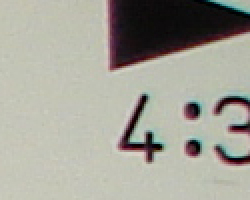 |
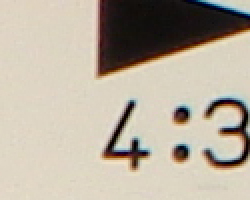 |
|
4-6 pixels, wide angle (200% magnification) |
2-3 pixels, telephoto (200% magnification) |
Chromatic aberration is moderate, showing about 4-6 pixels of moderately bright coloration on either side of the target lines at the wide angle lens setting. (This distortion is visible as a very slight colored fringe around the objects at the edges of the field of view on the resolution target.) However, at telephoto, chromatic aberration is very low.
Corner Sharpness
Only slight softening in all four corners.
 |
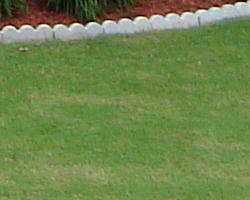 |
|
Only slightly soft in the lower left corner. |
Similar results on the right. |
The Sony DSC-S40 showed quite a bit less blurring in the corners than I've come to expect from subcompact digital cameras, with only a very small amount visible.
Sensor
Exposure
Indoor Portraits were warm, with a strong orange cast, and flash portraits required the maximum flash intensity setting.
|
Auto White Balance |
Incandescent WB |
Color balance indoors under incandescent was very warm in Auto mode, with the blue flowers appearing a very dark purple. The Incandescent setting produced better results, though still with a warm, reddish cast. The shot required a +1.3 EV exposure compensation boost to get a good exposure, which is a little higher than average. Our test lighting for this shot is a mixture of 60 and 100 watt household incandescent bulbs. This is a pretty yellow light source, but a very common one in typical home settings here in the US.
See the full set of test images on our thumbnail index page.Resolution
High resolution, 1,100 lines of strong detail.
Our laboratory resolution chart reveals sharp, distinct line patterns down to about 1,200 lines per picture height horizontally (1,100 lines vertically), with extinction at around 1,500 lines. Use these numbers to compare with other cameras of similar resolution, or use them to see just what higher resolution can mean in terms of potential detail. Beware that while you might be able to make out what looks like distinct lines at numbers higher than those we've mentioned here, the camera is just doing its best to continue interpreting the lines. If you zoom in and follow them from the wider portions, you'll see the lines converge and reappear several times, so the lines you see at 1,500 and higher are really only artifacts generated by the camera's imaging system.
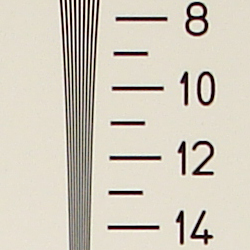 |
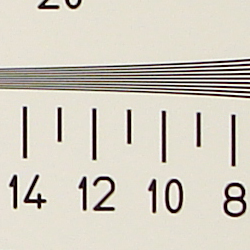 |
|
Strong detail to 1,200 lines horizontal |
Strong detail to 1,100 lines vertical |
See the full set of test images on our thumbnail index page.
Sharpness & Detail
Reasonable sharpness, though finer details are slightly soft.
The Sony DSC-S40's images are reasonably sharp overall, though finer details such as the foliage in the outdoor house shot and small details in the Macro shot are a bit soft. The camera's noise suppression system also reduces the level of sharpness in shadow areas. (Noise-suppression systems in digital cameras tend to flatten-out detail in areas of subtle contrast. The effects can often be seen in shots of human hair, where the individual strands are lost and an almost "watercolor" look appears.)
Slightly high noise overall, with moderately high noise even at the lower sensitivity settings.
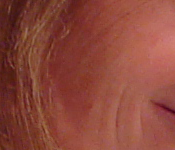 |
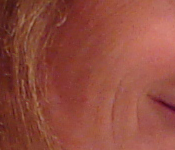 |
ISO 80 |
ISO 100 |
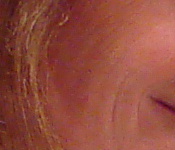 |
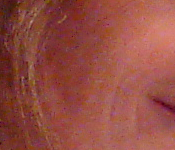 |
|
ISO 200 |
ISO 400 |
The DSC-S40 produced moderate to moderately high noise at its lower ISO settings. At ISO 400, noise is quite high, with bright pixels and less detail definition. Above, you can see a crop from a test image at each ISO setting.
High resolution with good detail, somewhat high contrast decreases highlight and shadow detail. Low-light capabilities are limited.
|
Normal |
+0.3EV |
+0.7EV |
Because digital cameras are more like slide film than negative film (in that they tend to have a more limited tonal range), we test them in the harshest situations to see how they handle scenes with bright highlights and dark shadows, as well as what kind of sensitivity they have in low light.
The Sony DSC-S40 has a little trouble here, and produces high contrast with dark midtones. Shadow detail is moderate, with moderately high noise, and the bright highlights show loss of detail as well.
Our low light testing revealed serious limitations in the lens and sensor's ability to gather and process light. Images are only bright to about one foot-candle, which is about the equivalent of average city street lighting at night, (though even here images are fairly dim). The chart below tells the story. If your subject is too far away for the flash, just forget it. Bottom line, the Sony DSC-S40 wouldn't be a first choice for after-dark photography.
| 1 fc 11 lux |
1/2 fc 5.5 lux |
1/4 fc 2.7 lux |
1/8 fc 1.3 lux |
1/16 fc 0.67 lux |
|
| ISO 80 |
1.6 sec f2.8 |
2 sec f2.8 |
2 sec f2.8 |
2 sec f2.8 |
2 sec f2.8 |
Color
Saturation & Hue Accuracy
Slightly warm overall color, with "hot" reds, though generally good overall saturation.
The other important part of color rendition is hue accuracy. Hue is "what color" the color is. On this score, the Sony DSC-S40 tended toward darker hues in the greens and blues, though the blue flowers of the bouquet don't show any strong purplish tints (many digital cameras produce deep purple tints here).
For "real world" results, see our Sony DSC-S40 Photo Gallery for more shots taken with the camera.
Viewfinder
Coverage
Very good accuracy from the LCD monitor, though the optical viewfinder is quite tight.
|
32mm equivalent, optical viewfinder |
96mm equivalent, optical viewfinder |
32mm equivalent, LCD monitor |
96mm equivalent, LCD monitor |
The DSC-S40's optical viewfinder proved quite tight, showing only about 80% frame accuracy at wide angle, and about 84% at telephoto. However, the LCD monitor proved much more accurate, showing close to 100% accuracy at both zoom settings. Images framed with the LCD monitor were actually just a hint loose, as my bold measurement lines were just cut off. Still good results though.
Flash
Coverage and Range
The Sony DSC-S40's flash is quite dim at the default intensity setting.
|
32mm equivalent |
96mm equivalent |
| Normal Flash | Slow-Sync Mode |
Flash coverage at both wide angle and telephoto shows some vignetting, and low overall intensity.
The flash on the Sony S40 also tended to underexpose somewhat. It has to be set to the High intensity setting to get a reasonable exposure even in our well-lit indoor scene. Slow-Sync mode captures more of the scene's essence, while filling in the shadows a bit, but still requires High flash compensation. The longer exposure in Slow-Sync mode also increases the orange cast.
In our low light test, below, even at eight feet, our closest test range, the flash was fairly weak, despite Sony's 12.5-foot maximum effectiveness specification.
| 8 ft | 9 ft | 10 ft | 11 ft | 12 ft | 13 ft | 14 ft |
| 1/40 sec f5.1 ISO 80 |
1/40 sec f5.1 ISO 80 |
1/40 sec f5.1 ISO 80 |
1/40 sec f5.1 ISO 80 |
1/40 sec f5.1 ISO 80 |
1/40 sec f5.1 ISO 80 |
1/40 sec f5.1 ISO 80 |
Output Quality
Print Quality
Good print quality, good color, very usable 8x10 prints. ISO 400 images are rough at 8x10, good at 5x7.
Testing hundreds of digital cameras, we've found that you can only tell just so much about a camera's image quality by viewing its images on-screen. Ultimately, there's no substitute for printing a lot of images and examining them closely. For this reason, we now routinely print sample images from the cameras we test on our Canon i9900 studio printer, and on the Canon iP5000 here in the office. (See the Canon i9900 review for details on that model.)
In the case of the Sony S40, we found that it had enough resolution to make good-looking 11x14 prints, although they were just a little soft. (More than good enough for wall display though.) Looking at the S40's high-ISO shots, images captured at ISO 400 looked a little rough, with a noticable watercolor effect due to the over-agressive noise processing, but surprisingly good when printed at 5x7 inches. At 4x6 inches, ISO 400 shots still showed some image noise, but you have to look pretty hard. Color-wise, the Sony S40's images looked great when printed on the iP5000, with bright, vibrant color. Complexion was somewhat red, and the flowers that looked blue onscreen went noticeably purple on the print.
Timing and Performance
Sony DSC-S40 Timing
Surprising speed for a consumer camera, very surprising in an inexpensive model.
| Startup: | |
|
Power On to first shot |
1.8 seconds |
| Shutter response (Lag Time): | |
|
Full Autofocus Wide |
0.34 second |
|
Full Autofocus Tele |
0.42 second |
|
Prefocused |
0.009 second |
| Cycle time (shot to shot) | |
|
Normal large/fine JPEG |
1.4 seconds |
|
Flash recycling |
8 seconds |
|
Continuous mode |
0.82 second 1.22 frames/second (4 large/fine frames) |
| "Multi Shot 16" |
0.03 second 30 frames/second (16 frames, any size) |
| Pro: | Con: |
|---|---|
|
|
| Free Photo Lessons | |
|
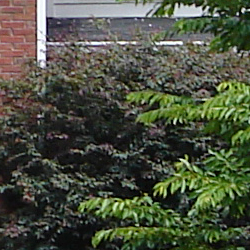
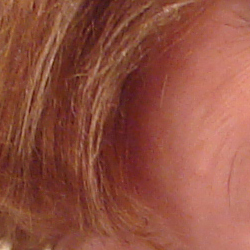


Follow Imaging Resource: